

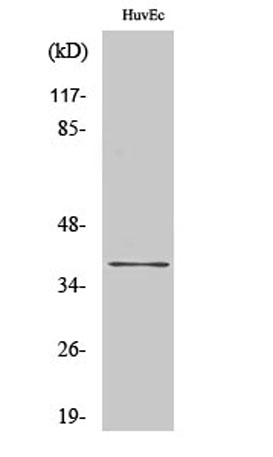
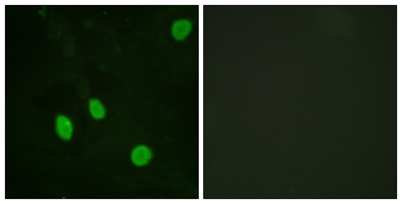
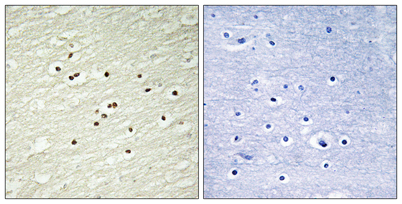
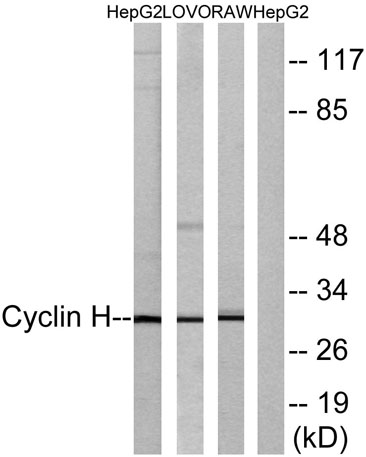
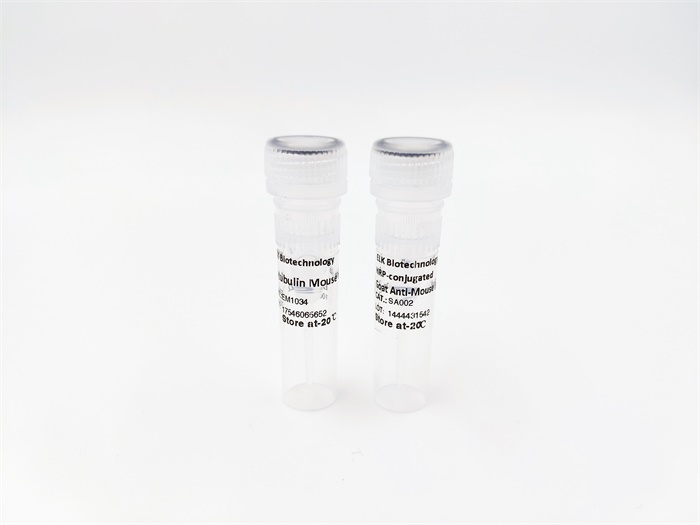



Cyclin H rabbit pAb
 One-click to copy product information
One-click to copy product information$148.00/50µL $248.00/100µL
| 50 µL | $148.00 |
| 100 µL | $248.00 |
Overview
| Product name: | Cyclin H rabbit pAb |
| Reactivity: | Human;Mouse;Rat |
| Alternative Names: | CCNH; Cyclin-H; MO15-associated protein; p34; p37 |
| Source: | Rabbit |
| Dilutions: | Western Blot: 1/500 - 1/2000. Immunohistochemistry: 1/100 - 1/300. Immunofluorescence: 1/200 - 1/1000. ELISA: 1/20000. Not yet tested in other applications. |
| Immunogen: | The antiserum was produced against synthesized peptide derived from human Cyclin H. AA range:274-323 |
| Storage: | -20°C/1 year |
| Clonality: | Polyclonal |
| Isotype: | IgG |
| Concentration: | 1 mg/ml |
| Observed Band: | 38kD |
| GeneID: | 902 |
| Human Swiss-Prot No: | P51946 |
| Cellular localization: | Nucleus. |
| Background: | The protein encoded by this gene belongs to the highly conserved cyclin family, whose members are characterized by a dramatic periodicity in protein abundance through the cell cycle. Cyclins function as regulators of CDK kinases. Different cyclins exhibit distinct expression and degradation patterns which contribute to the temporal coordination of each mitotic event. This cyclin forms a complex with CDK7 kinase and ring finger protein MAT1. The kinase complex is able to phosphorylate CDK2 and CDC2 kinases, thus functions as a CDK-activating kinase (CAK). This cyclin and its kinase partner are components of TFIIH, as well as RNA polymerase II protein complexes. They participate in two different transcriptional regulation processes, suggesting an important link between basal transcription control and the cell cycle machinery. A pseudogene of this gene is found on chromosome 4. Alternate splicing results in multiple t |
-
 Western Blot analysis of various cells using Cyclin H Polyclonal Antibody cells nucleus extracted by Minute TM Cytoplasmic and Nuclear Fractionation kit (SC-003,Inventbiotech,MN,USA).
Western Blot analysis of various cells using Cyclin H Polyclonal Antibody cells nucleus extracted by Minute TM Cytoplasmic and Nuclear Fractionation kit (SC-003,Inventbiotech,MN,USA). -
 Immunofluorescence analysis of HeLa cells, using Cyclin H Antibody. The picture on the right is blocked with the synthesized peptide.
Immunofluorescence analysis of HeLa cells, using Cyclin H Antibody. The picture on the right is blocked with the synthesized peptide. -
 Immunohistochemistry analysis of paraffin-embedded human brain tissue, using Cyclin H Antibody. The picture on the right is blocked with the synthesized peptide.
Immunohistochemistry analysis of paraffin-embedded human brain tissue, using Cyclin H Antibody. The picture on the right is blocked with the synthesized peptide. -
 Western blot analysis of lysates from HepG2, LOVO, and RAW264.7 cells, using Cyclin H Antibody. The lane on the right is blocked with the synthesized peptide.
Western blot analysis of lysates from HepG2, LOVO, and RAW264.7 cells, using Cyclin H Antibody. The lane on the right is blocked with the synthesized peptide.

 Manual
Manual